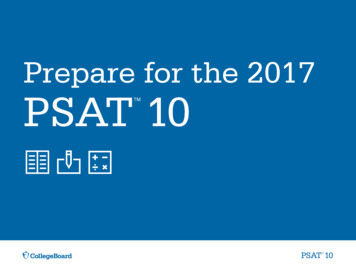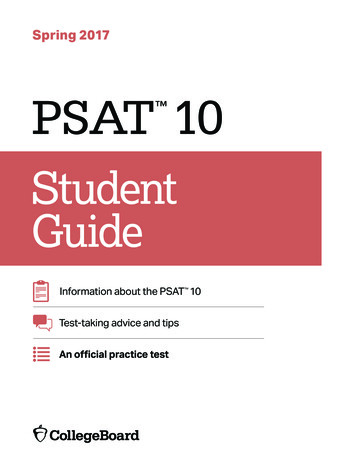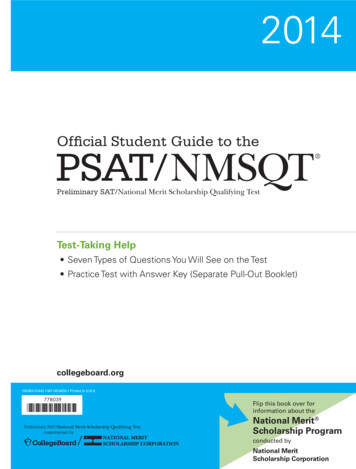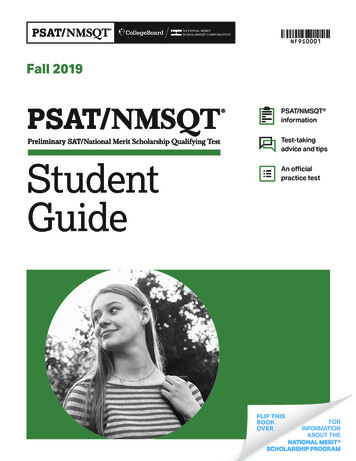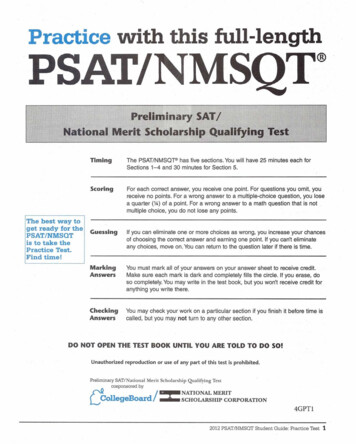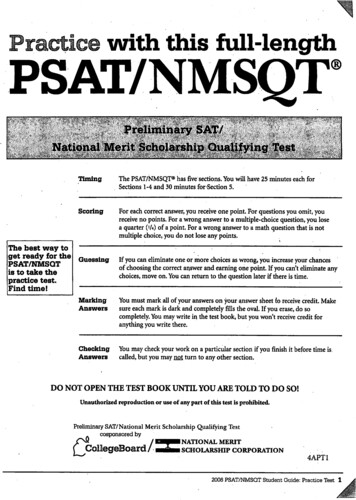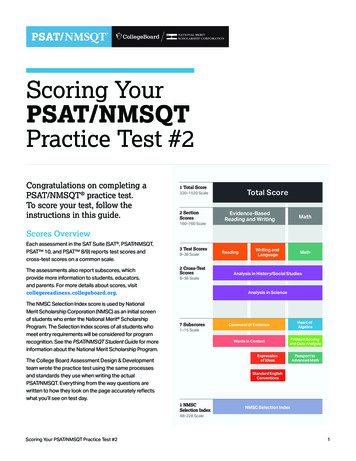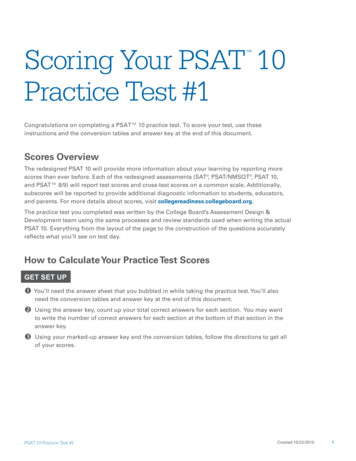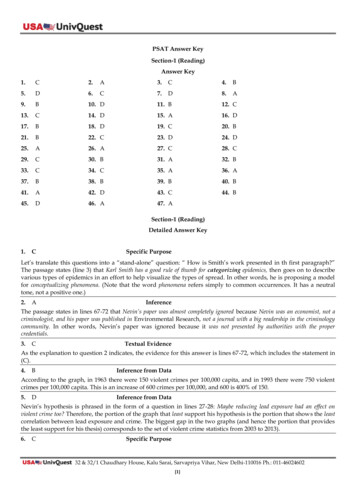
Transcription
PSAT Answer KeySection-1 (Reading)Answer Key1.C2.A3.C4.B5.D6.C7.D8.A9.B10. D11. B12. C13.C14. D15. A16. D17.B18. D19. C20. B21.B22. C23. D24. D25.A26. A27. C28. C29.C30. B31. A32. B33.C34. C35. A36. A37.B38. B39. B40. B41.A42. D43. C44. B45.D46. A47. ASection-1 (Reading)Detailed Answer Key1.CSpecific PurposeLet’s translate this questions into a “stand-alone” question: “ How is Smith’s work presented in th first paragraph?”The passage states (line 3) that Karl Smith has a good rule of thumb for categorizing epidemics, then goes on to describevarious types of epidemics in an effort to help visualize the types of spread. In other words, he is proposing a modelfor conceptualizing phenomena. (Note that the word phenomena refers simply to common occurrences. It has a neutraltone, not a positive one.)2.AInferenceThe passage states in lines 67-72 that Nevin’s paper was almost completely ignored because Nevin was an economist, not acriminologist, and his paper was published in Environmental Research, not a journal with a big readership in the criminologycommunity. In other words, Nevin’s paper was ignored because it was not presented by authorities with the propercredentials.3.CTextual EvidenceAs the explanation to question 2 indicates, the evidence for this answer is lines 67-72, which includes the statement in(C).4.BInference from DataAccording to the graph, in 1963 there were 150 violent crimes per 100,000 capita, and in 1993 there were 750 violentcrimes per 100,000 capita. This is an increase of 600 crimes per 100,000, and 600 is 400% of 150.5.DInference from DataNevin’s hypothesis is phrased in the form of a question in lines 27-28: Maybe reducing lead exposure had an effect onviolent crime too? Therefore, the portion of the graph that least support his hypothesis is the portion that shows the leastcorrelation between lead exposure and crime. The biggest gap in the two graphs (and hence the portion that providesthe least support for his thesis) corresponds to the set of violent crime statistics from 2003 to 2013).6.CSpecific Purpose32 & 32/1 Chaudhary House, Kalu Sarai, Sarvapriya Vihar, New Delhi-110016 Ph.: 011-46024602{1}
The sales of vinyl Lps are mentioned to describe a statistic that also happens to correlate with preschool blood leadlevels, thereby making the point that a single correlation between two curves isn’t all that impressive, econometricallyspeaking . . . No matter how good the fit, if you only have a single correlation it might just be coincidence. Hence, it is a statisticthat may be more coincidental than explanatory.7.DInterpretationThe sentence in lines 21-24 indicates that lead exposure in small children [head been linked] with a whole raft of complicationlater in life, including lower IQ, hyperactivity, behavioral problems, and learning disabilities. These complications arepsychological problems for those exposed to lead at a young age.8.AInterpretationWhen the passage states that the drivers were unwittingly creating a crime wave two decades later (lines 63-64), it indicatesthat they were inadvertent abettors.9.BWord in ContextThe phrase even better (line 49) refers to the finding mentioned in the previous sentence that the similarity of the curveswas as good as it seemed, suggesting that the data showed an even stronger correlation than Nevin had hoped.10. DSpecific PurposeThe final paragraph discusses the fact that the gasoline lead hypothesis explains many additional phenomena, such as thedifference between the murder rates in large cities (where there are lots of cars) and small cities (where there are fewercars and therefore less lead exhaust exposure). These implication further support the hypothesis.11. BCross-Textual InferenceThe author of Passage 1 indicates that Hemingway was a legendary figure whose work seemed . . . to have been carvedfrom the living stone of life (lines 25-26) and therefore had a great impact on the author and his friends. Passage 2,however, suggests that Hemingway’s works don’t have the impact they once did, saying that they now seem unable toevoke the same sense of a tottering world that in the 1920s established Ernest Hemingway’s reputation (lines 48-50) and nolonger seem to penetrate deeply the surface of existence (lines 57-58). Therefore, the two passages disagree most strongly onthe incisiveness (deep analytical quality) of Hemingway’s work.12. CTextual EvidenceAs the answer to the previous question indicates, the best evidence for this answer is found in lines 24-26 and lines 5658.13. CCross-Textual InterpretationThe author of Passage 1 regards Hemingway as a legend (line 16) whose impact upon us was tremendous (lines 18-19), butthe author of Passage 2 calls Hemingway a dupe of his culture rather than its moral-aesthetic conscience (lines 66-67).14. DCross-Textual InferenceThe author of Passage 1 indicates that, although Hemingway’s work had a strong formative impact on him, itultimately could not capture the true horrors of war that he and his friends were later to encounter:The Hemingway time was a good time to be young. We had much then that the war later forced out of us, something fargreater than Hemingway’s strong formative influence (Lines 33-36).Likewise, the author of Passage 2 indicates that Hemingway’s work did not fully capture the horrors of war: Wehave had more war than Hemingway ever dreamed of (lines 53-54) . . . yet Hemingway’s great novels no longer seem to penetratedeeply the surface of existence (lines 56-58).15. AWord in Context, PurposeIn saying that the words he put down seemed to us to have been carved from the living stone of life (lines 24-26), the author ofPassage 1 means that Hemingway’s words represent living truths that have the weight and permanence of stonecarving. In other words, his words represent the salient (prominent and important) experience of life.16. DInterpretationIn saying that we began unconsciously to translate our own sensations into their terms and to impose on everything we did andfelt the particular emotions they aroused in us (lines 28-32) the author is saying that he and his friends identified withHemingway’s language.17. BInference32 & 32/1 Chaudhary House, Kalu Sarai, Sarvapriya Vihar, New Delhi-110016 Ph.: 011-46024602{2}
According to Passage 1, the lesson that [Hemingway] had to teach (line 43) included the example he set as a warcorrespondent writing a play in the Hotel Florida in Madrid while thirty fascist shells crashed through the roof (lines 10-12)and as a soldier defending his post single handedly against fierce German attacks (lines 13-15), both of which exemplifyconfidence in the face of danger.18. DSpecific PurposeThe phrase a tottering world (line 49) is used to describe the Europe of the 1920s that Ernest Hemingway depicts in hisnovels. The author compares this world to one whose social structure is . . . shaken (lines 51-52) and which had more warthan Hemingway ever dreamed of (line 54). In other words, a world filled with societal upheaval.19. CCross-Textual InferenceThe author of Passage 1 clearly views Hemingway as a personal and literary hero. Hence, a withering accusation suchas the one in Passage 2 that Hemingway, in effect, became a dupe of his culture rather than its moralaesthetic conscience (lines66-67) would almost certainly be met with vehement disagreement.Tips: Questions about how the author of one passage might most likely respond to some statement in anotherpassage require us to focus on the thesis and tone of that author. Before attempting to answer such questions, remindyourself of the central theses of the passages.20. BTextual EvidenceThe best evidence for this answer comes from lines 28-32, where the author of Passage 1 says that we began tounconsciously translate our own sensations into their terms and to impose on everything we did and felt the particular emotionsthey aroused in us. In other words, Hemingway was in fact a kind of moral-aesthetic conscience for the author of Passage 1and his friends.21. BInterpretationPassage 2 states that Hemingway’s novels yielded to the functionalist, technological aesthetic of the culture instead of resistingin the manner of Frank Lloyd Wright (lines 63-66). In other words, Frank Lloyd Wright was more iconoclastic (culturallyrebellious) than Hemingway.22. CSpecific PurposeThe first paragraph establishes the idea that atoms, the building blocks of everything we know and love . . . don’t appear to bemodels of stability, a fact that represents a scientific conundrum (riddle), because instability is not a quality that we expectof building blocks.23. DWord in ContextBy asking [W/hy are some atoms, like sodium, so hyperactive while others, like helium, are so aloof? the author is drawing adirect contrast between chemical reactivity and relative non-reactivity.24. DInferenceThis question, about why protons stick together in atomic nuclei, is the guiding question for the passage as a whole.The next paragraph analyzes this question in more detail, explaining why this well-known fact is actually so puzzling.The remainder of the passages discusses attempts to resolve this puzzle, which remains at the heart of quantumphysics.25. ATextual EvidenceThe evidence that this question represents a central conundrum is found in lines 1-5, where the author makes theuncontroversial claim that a sound structure requires stable materials, but then makes the paradoxical claim that atoms, thebuilding blocks of everything we know and love . . . don’t appear to be models of stability.26. ASpecific PurposeThe two sentences in lines (We are told . . . electrons. We are also told . . . closer) indicate that we, the educated public,have been taught two seemingly contradictory facts about atoms. In other words, these are predominant conceptions.27. CInference from DataIn the graph, the equilibrium point is indicated by a dashed vertical line labeled Equilibrium. If we notice where thisline intersects the two curves, we can see that the corresponding strong nuclear force. That is, the equilibrium point iswhere the two forces “cancel out” and have and have a sum of 0.28. CInference Data32 & 32/1 Chaudhary House, Kalu Sarai, Sarvapriya Vihar, New Delhi-110016 Ph.: 011-46024602{3}
Tips: When a question asks about a graph or table, it helps to circle the words or phrases in the question thatcorrespond to the words or phrases in the graph or table. In this case, circle the key phrases electrostatic repulsion andseparated by 1.5 femtometers in both the question and the graph.Now, if we go to the graph and find the vertical line that corresponds to a separation of 1.5 femtometers, we can seethat it intersects the curve for electrostatic force at the horizontal line representing 102, or 100, Newtons.29. CInterpretationIn the fourth paragraph, we are told that Hideki Yukawa proposed that the nuclear force was conveyed by a thenundiscovered heavy subatomic particle he called the pi meson (or “pion”), which (unlike the photon) decays very quickly andtherefore conveys a powerful force only over a very short distance (lines 44-49). However, his theory was dealt a mortal blow bya series of experiments . . . that demonstrated that pions carry force only over distances greater than the distance between boundprotons (lines 50-55). In other words, pions are ineffective in the range required by atomic theory, so they cannot be thecarriers of the strong nuclear force.30. BGeneral StructureThe first paragraph of this passage introduces the scientific conundrum of how protons adhere in atomic nuclei. Thesecond paragraph analyzes this strange situation.The third paragraph describes a force, the strong nuclear force, that could solve the conundrum. The fourth paragraphdescribes a particular theory, now refuted, about what might convey this strong nuclear force. The fifth and sixthparagraphs indicate that the problem has yet to be satisfactorily resolved. Thus, the passage as a whole is a descriptionof a technical puzzle and the attempts to solve it.31. ALiterary DevicesA rhetorical question is a question intended to convey a point of view, rather than suggest a point of inquiry.Although the first and second paragraphs include five questions, they are all inquisitive, not rhetorical.The passage includes illustrative metaphors in lines 15-16 (a cloud of speedy electrons) and lines 55-56 (a plumber’swrench trying to do a tweezer’s job), technical specifications in lines 29-40 (First, it can’t have . . . each other), and appealsto common intuition in lines 1-2 (a sound structure . . . materials) and lines 13-16 (We are . . . electrons).32. BWord inContextThe hope that QCD ties up atomic behavior with a tidy little bow is the hope that the QCD theory resolves the problem in atidy way.33. CGeneral PurposeThe passage as a whole develops the thesis that the wise legislator does not begin by laying down laws good in themselves,but by investigating the fitness of the people, for which they are destined, to receive them (lines 3-6). In other words, thepassage is concerned with examining the social conditions that foster effective legal systems.34. CWord in ContextIn saying that the architect sounds the site to see if it will bear the weight, the author means that the architect probes theproposed location for a building to make sure that it is safe to build upon.35. ASpecific PurposeThe analogy of the architect in the first paragraph illustrates the thesis of the passage that the wise legislator does notbegin by laying down laws good in themselves, but by investigating the fitness of the people, for which they are destined, to receivethem (lines 3-6). That is, that a nation’s civil code depends on the nature of its people. Choice (B) is incorrect because theanalogy is not about the foundational principles of laws, but rather the fitness of the people for whom they are intended.36. AInferenceThe author states that as a nation grows older, its citizensbecome incorrigible (unable to be improved). Once customs havebecome established and prejudices inveterate (deep-seated), it is dangerous and useless to attempt their reformation (lines 1921). That is, the people become stubbornly resistant to political change.37. BTextual EvidenceAs the explanation to the previous question indicates, the relevant evidence is found in lines 20-21.38. BInterpretationWhen the author says that [m/ost peoples, like most men, are docile only in youth (lines 17-18), he is saying that societies(the people) as well as individuals (men) become less manageable as they age.32 & 32/1 Chaudhary House, Kalu Sarai, Sarvapriya Vihar, New Delhi-110016 Ph.: 011-46024602{4}
39. BSpecific PurposeThe author refers to Sparta at the time of Lycurgus (line 35) as an example of a state, set on fire by civil wars, [which] is bornagain (lines 31-32). That is, a society rejuvenated by conflict. Choice (A) may seem tempting, because the beginning of theparagraph mentions the fact that periods of violence (lines 28-29) can make people forget the past, but the paragraphexplains that this forgetting has the effect of renewal, not paralysis.40. BInterpretationAlthough the word constitution can be used to mean the documented rules by which a nation defines its governmentalinstitutions (as in the Constitution of the United States of America), the phrase the constitution of the state, as it is used inthis passage, clearly refers to the composition of the state, that is, the people who constitute the nation.41. AInterpretationIn saying that [o/ne people is amenable to discipline from the beginning; another, not even after ten centuries (Lines 51-53), theauthor means that some nations are ready to be governed by the rule of law as soon as they are founded, but othersrequired much more time.42. DInferenceThe passage states that Peter the Great . . . lacked true genius [because he] did not see that [his nation] was not ripe forcivilization: he wanted to civilize it when it needed only hardening (lines 55-61). In other words, he did not give his nationthe hardening it needed: his flaw was his irresolution (hesitancy due to a lack of conviction) in exerting control.43. CGeneral PurposeThe first sentence of the passage establishes its central purpose: to understand the views of Aristotle, and asserts that todo this it is necessary to apprehend his imaginative background (lines 1-3). In other words, the purpose of this passage is todescribe the conceptions that inform a particular mindset.44. BInferenceWhen the author states that Animals have lost their importance in our imaginative pictures of the world (lines 29-30), he isreinforcing his point that modern students are accustomed to automobiles and airplanes; they do not, even in the dimmestrecesses of their subconscious imagination, think that an automobile contains some sort of horse inside, or that an airplane fliesbecause its wings are those of a bird possessing magical powers (lines 23-29). In other words, animistic beliefs no longer informour physical theories.45. DInterpretationWhen the author states that every philosopher, in addition to the formal system that he offers to the world, has another muchsimpler system of which he may be quite unaware (lines 3-6) the simpler system refers to the imaginative background (line 3)that informs a scientist’s formal theories. However, if a scientist is aware of this simpler system, he probably recognizesthat it won’t do (line 7). Therefore, this system is a relatively unrefined way of thinking46. AInferenceIn lines 61-65, the author states that it was natural that a philosopher who could no longer regard the heavenly bodiesthemselves as divine should think of them as moved by the will of a Divine Being who had a Hellenic love of order and geometricsimplicity. In other words, the astronomical theories of some ancient Greek philosophers were closely associated withtheir religious ides.47. ATextual EvidenceAs the explanation to the previous question indicates, the evidence for this answer is in lines 61-65.32 & 32/1 Chaudhary House, Kalu Sarai, Sarvapriya Vihar, New Delhi-110016 Ph.: 011-46024602{5}
Section-2 (Writing & Language)Answer Key1.C2.A3.B4.B5.B6.A7.D8.C9.A10. B11. B12. C13.A14. B15. A16. B17.D18. C19. D20. B21.B22. B23. D24. A25.D26. C27. B28. B29.C30. D31. A32. A33.D34. D35. A36. C37.C38. D39. A40. C41.A42. C43. B44. B32 & 32/1 Chaudhary House, Kalu Sarai, Sarvapriya Vihar, New Delhi-110016 Ph.: 011-46024602{6}
32 & 32/1 Chaudhary House, Kalu Sarai, Sarvapriya Vihar, New Delhi-110016 Ph.: 011-46024602{7}
32 & 32/1 Chaudhary House, Kalu Sarai, Sarvapriya Vihar, New Delhi-110016 Ph.: 011-46024602{8}
32 & 32/1 Chaudhary House, Kalu Sarai, Sarvapriya Vihar, New Delhi-110016 Ph.: 011-46024602{9}
32 & 32/1 Chaudhary House, Kalu Sarai, Sarvapriya Vihar, New Delhi-110016 Ph.: 011-46024602{10}
Section-3 (Math 1)Answer Key1.D2.B3.C4.C5.A6.C7.D8.A9.A10. D11. B13.A14. 1315. –4/3 (8/3 or 2.66 or 2.67)16.017.4012. ASection-4 (Math 2)Answer Key1.B2.A3.D4.A5.B6.C7.C8.A9.D10. A11. B12. C13.D14. A15. B16. D17.D18. C19. A20. C21.A22. D23. B24. B25.B26. A27. D28. 629.59/52 or 1.13 or 1.1430. 30031. 15032 & 32/1 Chaudhary House, Kalu Sarai, Sarvapriya Vihar, New Delhi-110016 Ph.: 011-46024602{11}
32 & 32/1 Chaudhary House, Kalu Sarai, Sarvapriya Vihar, New Delhi-110016 Ph.: 011-46024602 {1} PSAT Answer Key Section-1 (Reading) Answer Key
